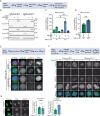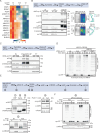Positively charged specificity site in cyclin B1 is essential for mitotic fidelity
- PMID: 39833154
- PMCID: PMC11747444
- DOI: 10.1038/s41467-024-55669-x
Positively charged specificity site in cyclin B1 is essential for mitotic fidelity
Abstract
Phosphorylation of substrates by cyclin-dependent kinases (CDKs) is the driving force of cell cycle progression. Several CDK-activating cyclins are involved, yet how they contribute to substrate specificity is still poorly understood. Here, we discover that a positively charged pocket in cyclin B1, which is exclusively conserved within B-type cyclins and binds phosphorylated serine- or threonine-residues, is essential for correct execution of mitosis. HeLa cells expressing pocket mutant cyclin B1 are strongly delayed in anaphase onset due to multiple defects in mitotic spindle function and timely activation of the E3 ligase APC/C. Pocket integrity is essential for APC/C phosphorylation particularly at non-consensus CDK1 sites and full in vitro ubiquitylation activity. Our results support a model in which cyclin B1's pocket facilitates sequential substrate phosphorylations involving initial priming events that assist subsequent pocket-dependent phosphorylations even at non-consensus CDK1 motifs.
© 2025. The Author(s).
Conflict of interest statement
Competing interests: The authors declare no competing interests.
Figures




References
-
- Hochegger, H., Takeda, S. & Hunt, T. Cyclin-dependent kinases and cell-cycle transitions: does one fit all? Nat. Rev. Mol. Cell Biol.9, 910–916 (2008). - PubMed
-
- Crncec, A. & Hochegger, H. Triggering mitosis. FEBS Lett.593, 2868–2888 (2019). - PubMed
-
- Kamenz, J. & Ferrell, J. E. The temporal ordering of cell-cycle phosphorylation. Mol. Cell65, 371–373 (2017). - PubMed
MeSH terms
Substances
Grants and funding
LinkOut - more resources
Full Text Sources
Miscellaneous

